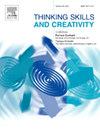From logs to insights: Exploring domains of creativity in data analytics tasks
IF 4.5
2区 教育学
Q1 Social Sciences
引用次数: 0
Abstract
Although creativity research has traditionally focused on observable outcomes, less attention has been given to the real-time behavioral and cognitive processes that underlie creative thinking. In this exploratory study, we investigate how creativity manifests in data analytics (DA) tasks - an increasingly important domain in both education and professional practice. By analyzing correlations between participants' self-reported creativity, as measured by the Kaufman Domains of Creativity Scale (K-DOCS) questionnaire, and their recorded behaviors as reflected in system log file data of DA platform, we found that different domains of creativity are linked to distinct behavioral patterns in DA tasks. The results show that among the five domains of creativity, the Scholarly domain was the most prominent. Participants with higher scholarly creativity scores achieved better outcomes in the DA task while using fewer actions, suggesting more efficient DA proficiency. These participants also used platform features such as “help” and "about" less frequently than others. The Artistic domain emerged as the second most prominent. Participants with higher levels of artistic creativity also completed the task successfully using fewer actions, implying that sensitivity to visual and structural cues may facilitate efficient DA proficiency. These findings contribute to the domain-specificity perspective on creativity by showing how distinct creativity profiles relate to different behavioral patterns in DA tasks. They also lay a foundation for developing less biased, more cost-effective, log-based assessment tools that can help educators and researchers identify and support creative thinking in DA tasks.
从日志到洞察:探索数据分析任务中的创造力领域
虽然创造力研究传统上关注可观察到的结果,但很少关注创造性思维背后的实时行为和认知过程。在这项探索性研究中,我们探讨了创造力如何在数据分析(DA)任务中表现出来——这是一个在教育和专业实践中日益重要的领域。通过分析考夫曼创造力领域量表(Kaufman Domains of creativity Scale, K-DOCS)中被试自我报告的创造力与数据处理平台系统日志文件数据中被试记录的行为之间的相关性,我们发现不同的创造力领域与数据处理任务中不同的行为模式相关。结果表明:在创造力的五个领域中,学术领域最为突出。学术创造力得分较高的参与者在使用较少动作的情况下,在数据分析任务中取得了更好的结果,这表明他们对数据分析的熟练程度更高。这些参与者使用“帮助”和“关于”等平台特征的频率也低于其他人。艺术领域成为第二重要的领域。艺术创造力水平较高的参与者使用较少的动作也成功地完成了任务,这意味着对视觉和结构线索的敏感性可能有助于有效地熟练掌握数据处理。这些发现通过展示不同的创造力特征与数据处理任务中不同的行为模式之间的关系,为创造力的领域特异性视角做出了贡献。它们还为开发更少偏见、更具成本效益、基于日志的评估工具奠定了基础,这些工具可以帮助教育工作者和研究人员识别和支持数据分析任务中的创造性思维。
本文章由计算机程序翻译,如有差异,请以英文原文为准。
求助全文
约1分钟内获得全文
求助全文
来源期刊

Thinking Skills and Creativity
EDUCATION & EDUCATIONAL RESEARCH-
CiteScore
6.40
自引率
16.20%
发文量
172
审稿时长
76 days
期刊介绍:
Thinking Skills and Creativity is a new journal providing a peer-reviewed forum for communication and debate for the community of researchers interested in teaching for thinking and creativity. Papers may represent a variety of theoretical perspectives and methodological approaches and may relate to any age level in a diversity of settings: formal and informal, education and work-based.
 求助内容:
求助内容: 应助结果提醒方式:
应助结果提醒方式:


